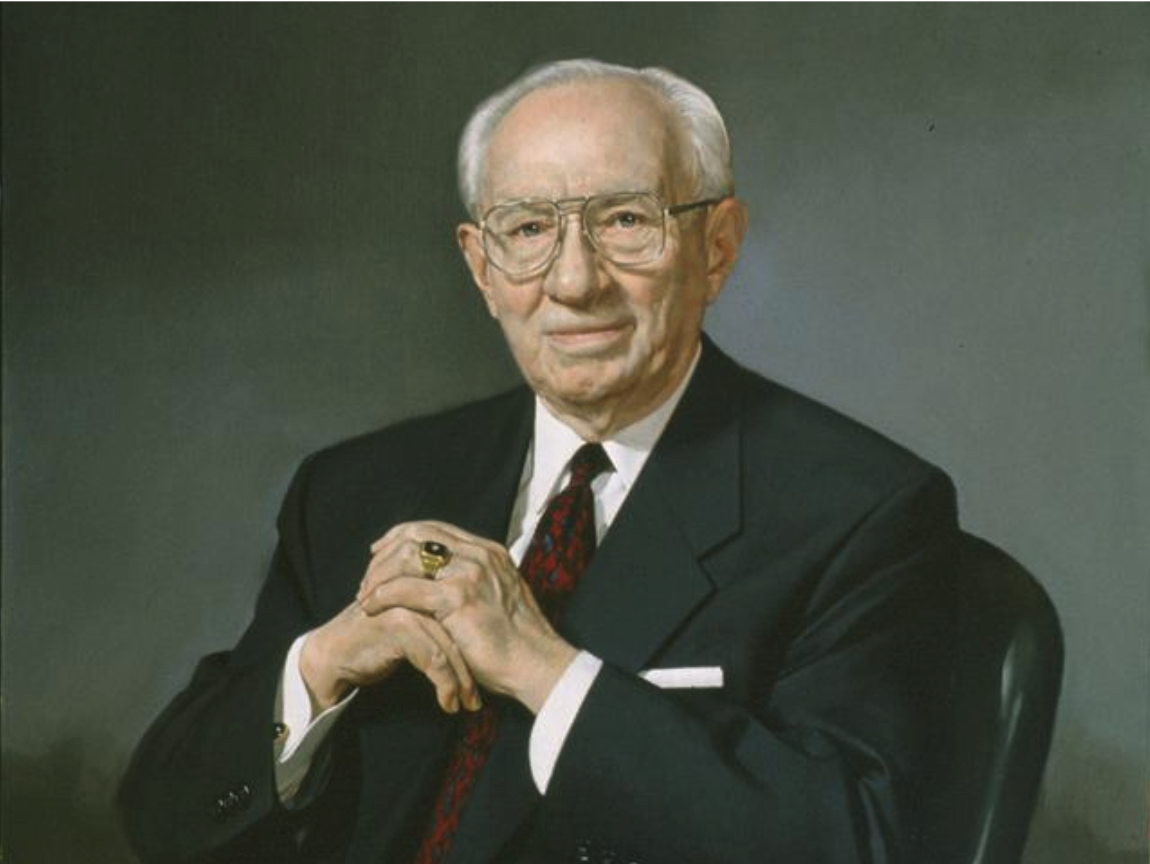
Image from LDS.org
A Tradition of Transparency
Gordon B. Hinckley was the 15th President of the Church of Jesus Christ of Latter-day Saints, serving as “prophet, seer, and revelator” from 1995 to 2008. During this period he made a number of public proclamations about Mormon Church finances and the overarching philosophies of the Church’s objectives and goals in this arena.
He addressed the idea that commercial ventures in which the LDS Church has participated are an exercise in financial wisdom and conservatism that the Church has strived to practice after more than a century of “close calls” wherein the Church teetered on the brink of bankruptcy.
It can be safely stated that the Church has been on firm financial footing since the late 1960s, after a period when several ambitious and expensive building projects were nearly abandoned, including the iconic Church Office Building in downtown Salt Lake City. Throughout its history, the LDS Church’s involvement in commercial enterprises has been rooted in survival, innovation, and a firm dedication to its 3-pronged mission to 1. preach the Gospel 2. perfect the Saints and 3. redeem the dead.
Commercial Ventures in LDS History
When President Hinckley was asked what are donations to the LDS Church used for, he articulated the following: “Essentially, the business assets which the Church has today are an outgrowth of enterprises which were begun in the pioneer era of our history when we were isolated in the valleys of the mountains of western America.” This insight gives a window into the genesis of the Church’s business initiatives, primarily born out of necessities associated with the physical isolation of the LDS Church from other, more developed parts of the world.
President Hinckley expanded upon this idea when he shared, “For instance, a newspaper was then needed to keep the people advised of what was going on at home and abroad. The result was the Deseret News, which has been published now for [150] years.” This exemplifies the Church’s determination to serve the population of its newly-settled territories and establish forms of communication that continue to serve the needs of its members well into the future.
Early in the 20th century the Church also made its first foray into the rising technologies of radio and television broadcasting. President Hinckley remarked, “In the 1920s, government officials encouraged newspapers to set up radio stations. That was in the infancy of the broadcasting industry. One such radio station was established by the Deseret News here in Salt Lake City. From that has grown, by the natural process of development, holdings of a number of broadcasting properties.” Such properties included Bonneville Productions and KSL radio and television, demonstrating the Church’s adaptability to leverage cutting-edge technologies to amplify its voice and augment its mission.
President Hinckley emphasized the purpose behind these enterprises when he said, “The ownership of these properties, both newspaper and broadcasting facilities, while they are operated as commercial entities, both directly and indirectly helps us in our responsibility to communicate our message and our point of view.” Here, President Hinckley underscores the dual nature of such ventures as both commercial enterprises and tools for communication, again serving the central mission of the Church to disseminate its teachings across the globe.
The Indispensable Role of Tithing
President Hinckley was clear that its commercial ventures provide only a moderate source of income and stressed the importance of Mormon Church tithing. Hinckley noted, “The combined income from all of these business interests is relatively small and would not keep the work going for longer than a very brief period.” This highlights that the Church’s primary income is still derived from the tithes and offerings of its members, placing commercial pursuits in a proper context as supportive in nature rather than central to the Church’s financial durability.
Through President Hinckley’s words, we gain a comprehensive view of how the LDS Church’s commercial entities are intrinsically linked to its history, mission, and values. Additionally, President Hinckley addressed such interesting topics as the unfolding tendency for government agencies of the United States and other countries to raise funds from lotteries or other forms of institutionalized gambling.
He reminded Church members of the following: “….in 1925, President Heber J. Grant and his counselors said, ‘The Church has been and now is unalterably opposed to gambling in any form. (Improvement Era, Sept. 1926, p. 1100.) Lotteries are advocated as a means of relieving the burden of taxation. That may be a political matter. But a tax by any other name is still a tax, except in this case the burden usually falls on the poor who can least afford to pay it. As an editorial in USA Today stated recently: ‘Lotteries aren’t painless—the overwhelming majority of players always lose. The game takes bread and money from the poor. And it is one more temptation for the compulsive gamblers who ruin careers and families with their addiction.’ (USA Today, 26 Aug. 1985.) In this context, it becomes a moral question.”
Setting an Enduring Example
Such philosophies on LDS finances demonstrate the modern Church’s commitment to community service, and exemplify its forward-looking principles of stewardship and innovation.
As we examine the LDS Church’s approach to commercial enterprises, we are reminded of the delicate balance of maintaining financial stability and remaining focused on the spiritual objectives of the living Church. The journey of the LDS Church from its pioneer days to its present-day global presence is nothing less than a testament to its long-ranging vision and relentless pursuit of loftier purposes. Its financial stewardship should serve as an example for ordinary, everyday Church members on how to navigate the modern world’s financial complexities while making a lasting, positive impact on its broader communities.

By Todd Noall, Source Expert
Todd Noall is an author and religious scholar at Mormonism Explained with a focus on the history and theology of religion.

Fact Checked by Mr. Kevin Prince, Source Expert
Kevin Prince is a religious scholar and host of the Gospel Learning Youtube channel. His channel has garnered over 41,000 subscribers and accumulated over 4.5 million views. Mr. Prince also created the Gospel Learning App, a reliable platform where individuals seeking truth can access trustworthy answers to religious questions from top educators worldwide.
About Mormonism Explained
Mormonism Explained is a resource that was designed to provide objective and factual information about Mormonism, its history, doctrines, and policies. Our team of researchers consults experts and primary sources to present factual information on a variety of topics relevant to the Mormon Church.
Tags
